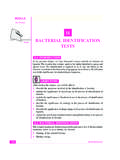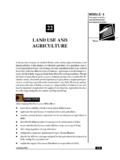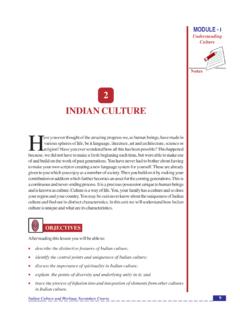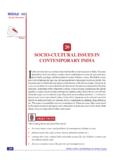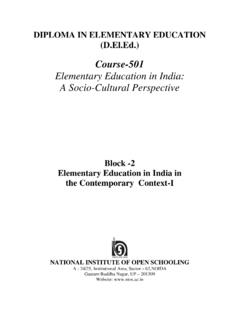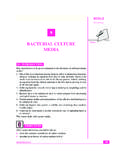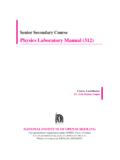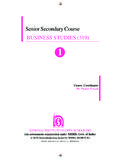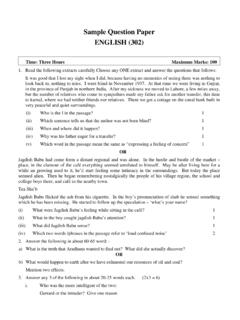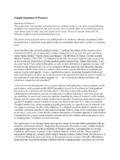Transcription of 17 SCIENTISTS OF MODERN INDIA T - National Institute of ...
1 SCIENTISTS of MODERN IndiaNotesIndian Culture and Heritage Secondary Course 246 MODULE - VIScience andTechnology17 SCIENTISTS OF MODERN INDIAThe development of scientific thought in MODERN INDIA can be attributed to the scientistsof this period. Towards the second half of the nineteenth century, Sir Ramanbrought about an unprecedented change in Indian scientific thought, Dr. Homi , known as the father of our Nuclear Physics, predicted the future of Indian Bose, in the field of plant physiology, Dr. Vikram Sarabhai, in the field of atomicenergy and industrialization and Dr. Abdul Kalam, in the field of defence technology, broughtabout revolutionary changes to reawaken the glory of MODERN INDIA OBJECTIVESA fter reading this lesson you will be able to : enumerate the important achievements of some of the great Indian SCIENTISTS ofmodern times: and enlist their contributions to the service of human society.
2 SRINIVAS RAMANUJAN (1887-1920)Srinivasa Aiyangar Ramanujan (FRS) better known as Srinivasa Iyengar Ramanujan, oneof INDIA s greatest mathematical genius, was born at Erode in Tamil Nadu on 22 December,1887. Later on, his parents shifted to Kumbakonam, 160 kilometres from studied at the Town Hall School in Kumbakonam, where he proved himself tobe an able all-rounder. However, his love of mathematics was unusual. Numbers seemedto draw him by a strange magnetism. In school itself at the age of thirteen, he came acrossa book called Synopsis of Elementary Results in Pure Mathemetic by G. S. outdated, this book introduced him to the world of mathematics. He started workingScientists of MODERN IndiaNotes 247 Indian Culture and Heritage Secondary CourseMODULE - VIScience andTechnologyand developing his own ideas in mathematics.
3 He used to write his ideas and results andmake notes on his of his research note books are available to us. They are called Ramanujan s FrayedNotebooks. He could not complete his college education as he kept on developing hisideas and started posing problems and solving them in the Journal of Indian MathematicalSociety. In 1911, he published in the same journal a brilliant research paper on BernoulliNumbers. This got him recognition and he became well known in Madras circles as amathematical of formal education made it very difficult for him to make both ends meet. With greatdifficulty he could get the job of a clerk at Madras Port Trust which proved fortunate forhim. Here he came in contact with many people who had training in mathematics.
4 Hefound a book Orders of Infinity written by G. H. Hardy. He wrote a letter to him inwhich he mentioned 120 theorems and formulae. Hardy was quick to recognise his geniusand he responded by arranging for him a passage to London. Despite his lack of requiredqualification he was allowed to enroll at Trinity College from where he got his Bachelor ofScience degree in less than two years. He formed a wonderful team with Hardy and and made amazing contributions to the field of mathematics. He publishedmany papers in London. He was the second Indian to be elected Fellow of the RoyalSociety of London and the first Indian to be elected Fellow of Trinity had an intimate familiarity with numbers. In 1917, he fell seriously ill, but thenumbers remained his friend, though his body betrayed him.
5 Unfortunately, his health becameworse and he returned to INDIA in 1919, With a scientific standing and reputation . Hedied in 1920. His mathematical genius is a proof that INDIA indeed is the birthplace andsource of great mathematical ideas. CHANDRASEKHARA V. RAMAN (1888-1970)Chandrasekhara V. Raman, popularly known as Raman, was not only a great scientistbut also believed in the promotion of human well being and human dignity. He won theNobel Prize for Physics in was the first Asian to receive this Raman was born on 7 November 1888 in Tiruchirapalli, in Tamil Nadu. His fatherwas a professor of Physics and Mathematics. He grew up in an environment of Sanskritliterature, music and science. Nature had gifted him with great power of concentration,intelligence and spirit of inquiry.
6 Even in his childhood, he was popular as a child stood first in the Indian Audit and Accounts (IAAS) Examination and was appointedas Assistant Accountant General in the Finance Department in Calcutta at the age of sacrificed his high post for his love for science and joined the Science College ofCalcutta University as a professor of Physics. Due to his deep love of music, he startedworking on musical instruments like the veena, violin, tabla and mridangam. In 1921, heScientists of MODERN IndiaNotesIndian Culture and Heritage Secondary Course 248 MODULE - VIScience andTechnologyread a paper on the theory of Stringed Instruments before the Royal Society of London. In1924, he was made Fellow of the Royal his journey to England, he was greatly attracted by the blue colour of the sea.
7 He wascurious to know why it remained blue even when big waves rolled up. Then he got theintuitive flash that it was due to the breaking up of sun s light by water molecules. Heconducted many experiments and prepared a long paper on molecular scattering of lightand sent it to the Royal Society of London. The world of science was dumb struck at thebrilliance of his EffectWhen a beam of monochromatic (having single colour) light passes through a transparentsubstance, it scatters. Raman studied the broken light. He found that there were twospectral lines of very low intensity (strength) parallel to the incident monochromatic showed that broken light was not monochromatic, though the incident light wasmonochromatic. Thus a great phenomenon hidden in nature was revealed to him.
8 Thisphenomenon became famous as Raman Effect and spectral lines in the scattered light asRaman Lines. While SCIENTISTS had been debating over the question whether light was likewaves or like particles, the Raman Effect proved that light is made up of particles knownas Raman was a great teacher and a great guide as well. He generated immense confidenceamong his students. One of his students was in very low morale because he had only onekilowatt powered X -Ray equipment, whereas a scientist in England was working with 5kilowatt powered X-Ray equipment. Dr. Raman inspired him to use his 10 kilowatt poweredbrain Raman s life is a great example for us to follow. Even when INDIA was under British ruleand there was hardly any basic infrastructure for experimentation, he used his great mindas his laboratory.
9 He proved through the example of his life, how our ancestors formulatedgreat theories using the power of their mind. JAGDISH CHANDRA BOSE Bose another great scientist of modem INDIA brought glory and respect for the was born on 30 November, 1858 at Mymensingh, now in Bangladesh, where he hadhis early education. He had his higher education at St. Xaviers College, Calcutta. In 1885he was appointed Assistant Professor of Physics at the Presidency College but refused totake salary because it was nearly half of that of an Englishman. Later on, he decided tobecome a scientist to recover the fame that INDIA enjoyed all over the world in ancienttimes. He made an apparatus to study the properties of electric waves. For his paper on The Electromagnetic Radiation and Polarization of Electric Ray , he was made a KnightScientists of MODERN IndiaNotes 249 Indian Culture and Heritage Secondary CourseMODULE - VIScience andTechnologyin 1917 and Fellow of the Royal Society of London in 1920.
10 He was the first Indianscientist in Physics to receive this Bose is famous all over the world as the inventor of Crescograph that can record eventhe millionth part of a millimeter of plant growth and movement. Dr. Bose proved throughgraphs taken by the Crescograph that plants have a circulatory system too. Crescographhas also shown that the upward movement of sap in plants is the activity of living Bose also made many other instruments famous all over the world as Bose instruments,to prove that even metals react to outward stimuli. Bose s instruments have shown, howeven steel and metals used in scissors and machinery get tired and regain efficiency after aperiod of Crescograph and other Bose instruments, his wireless inventions too antedatedthose of Marconi.
